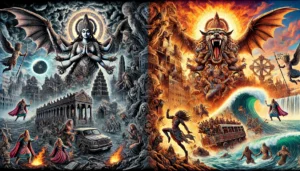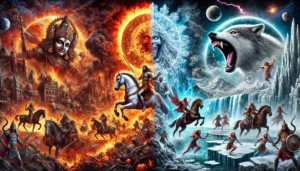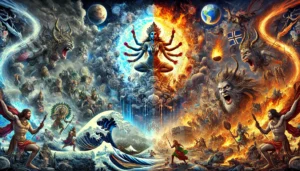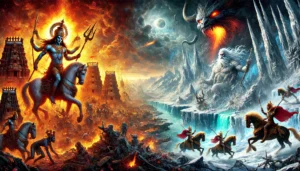
End of the world kaliyuga and ragnarok
End-of-World Myths: From Kali Yuga in Hinduism to Ragnarök in Norse Mythology
The concept of the world ending has intrigued humanity for millennia, sparking vivid myths and legends across cultures. These narratives often explore themes of moral decline, cosmic battles, and the promise of renewal. Two such fascinating end-of-world myths are the Kali Yuga from Hinduism and Ragnarök from Norse mythology. These stories not only reflect the worldview of their respective cultures but also carry timeless messages about morality, hope, and the cycles of existence.
Table of Contents
Kali Yuga: The Age of Darkness in Hinduism
In Hinduism, time is perceived as cyclical, a never-ending loop of creation, preservation, and destruction. The cycle is divided into four Yugas (epochs): Satya Yuga, Treta Yuga, Dvapara Yuga, and Kali Yuga. Each Yuga represents a gradual decline in virtue and righteousness. Kali Yuga, the fourth and final age, is often described as the darkest period in the cosmic timeline.
Characteristics of Kali Yuga
Hindu scriptures like the Mahabharata, Vishnu Purana, and Bhagavata Purana detail the hallmarks of this age:
Moral and Spiritual Decay: Truth, compassion, and righteousness diminish, leaving greed, anger, and lust to dominate.
Corruption in Society: Leaders become tyrannical, families disintegrate, and relationships lose sincerity.
Neglect of Dharma: The pursuit of material wealth overshadows spiritual practices, and faith erodes.
According to Hindu cosmology, Kali Yuga spans 432,000 years and began approximately 5,000 years ago. Despite its grim outlook, this age is not devoid of hope. The arrival of Kalki, the prophesied 10th avatar of Vishnu, will mark the end of Kali Yuga. Kalki is said to restore dharma, vanquish evil, and usher in the pristine Satya Yuga, beginning a new cycle of cosmic time.
Lessons from Kali Yuga
For readers of “Prachin Sanatan Yuga,” Kali Yuga offers a profound reminder: even in the darkest times, there is a promise of divine intervention and renewal. The struggles of this age encourage introspection and the pursuit of spiritual growth, even amid chaos.

End of the world kaliyuga and ragnarok
Ragnarök: The Twilight of the Gods in Norse Mythology
In the Norse worldview, time moves toward an ultimate conclusion marked by Ragnarök, a series of apocalyptic events. Unlike the cyclical nature of Hinduism, Norse mythology presents Ragnarök as a linear narrative culminating in destruction and rebirth.
The Events of Ragnarök
Ragnarök unfolds dramatically, as foretold in the Poetic Edda and Prose Edda. It begins with:
Fimbulvetr: A prolonged winter that leads to famine, societal collapse, and the breakdown of moral order.
Cosmic Battles: The gods face their adversaries in a final confrontation. Odin battles Fenrir, Thor fights Jörmungandr, and Loki opposes Heimdall.
Amid the chaos, the world succumbs to destruction:
The sun and moon are devoured by wolves, plunging the cosmos into darkness.
The earth sinks into the sea, consumed by fire and floods.
Renewal After Ragnarök
However, the myth concludes with hope. A new earth rises, verdant and fertile, where the surviving gods and two human beings, Líf and Lífþrasir, begin anew. This emphasis on regeneration resonates with the universal human desire for renewal after catastrophe.

End of the world kaliyuga and ragnarok
Connecting the Myths
While Kali Yuga and Ragnarök stem from distinct cultural and geographical contexts, they share fascinating parallels:
Both myths depict an age of moral and societal collapse preceding the end.
Destruction is not the final act; instead, a new, purer world emerges.
Divine figures, like Kalki in Hinduism and the surviving gods in Norse mythology, play critical roles in restoring order.
However, they differ in their conceptualization of time. Hinduism’s cyclical perspective emphasizes eternal recurrence, while Norse mythology’s linear narrative portrays Ragnarök as a climactic conclusion followed by rebirth.
Relevance in Modern Times
For readers of “Prachin Sanatan Yuga,” these myths hold profound relevance in today’s world. They resonate with the challenges of our times—climate change, social unrest, and moral dilemmas. Both Kali Yuga and Ragnarök remind us that while destruction and hardship are inevitable, they also pave the way for renewal.
The hope embedded in these stories encourages us to focus on restoring dharma (righteousness) in our own lives. By learning from the past and embracing spiritual and moral principles, we can prepare for a better future, much like the new worlds envisioned in these myths.
As you explore these ancient tales on “Prachin Sanaran Yuga,” consider their timeless wisdom. They are more than mere myths—they are mirrors reflecting our collective fears and aspirations, guiding us toward a brighter, more harmonious existence.

End of the world kaliyuga and ragnarok
FAQs: End-of-World Myths: Exploring Kali Yuga in Hinduism and Ragnarök in Norse Mythology
- What are end-of-world myths, and why do they exist in nearly all cultures?
End-of-world myths are stories or beliefs about the ultimate fate of the world, often involving destruction followed by renewal or salvation. They exist across cultures because they address universal human concerns about mortality, the passage of time, and the survival of humanity. These myths also serve as moral frameworks, warning against actions that could lead to chaos or destruction.
- What are the main features of Kali Yuga in Hinduism?
In Hindu texts, Kali Yuga is characterized by:
Moral Decay: Dishonesty, greed, and selfishness dominate.
Loss of Dharma (Righteousness): Virtuous behavior declines, and people drift away from spiritual practices.
Shortened Lifespans: People’s lives become shorter compared to earlier yugas.
Natural Disasters: Wars, famines, and ecological destruction increase.
Kali Yuga is said to last for 432,000 years, and we are currently over 5,000 years into it, according to traditional Hindu calculations.
- What events lead to and follow Ragnarök in Norse mythology?
Signs of Ragnarök: These include the death of Balder, a god of light and purity, and the Fimbulwinter, a harsh and prolonged winter.
The Great Battle: Gods, led by Odin, clash with giants, wolves, and other chaos forces. Many major gods, including Odin and Thor, perish.
Destruction of the World: The earth is consumed by fire and sinks into the sea.
Rebirth: A new earth rises, and the surviving gods, along with two human beings (Lif and Lifthrasir), repopulate and renew the world.
- How do other cultures approach the idea of the world’s end?
Aztec Mythology: The Aztecs believed in the Five Suns, representing five successive worlds. They were living in the fifth world, destined to end in earthquakes.
Abrahamic Religions: In Christianity, Islam, and Judaism, apocalyptic themes include divine judgment, resurrection, and the establishment of a divine kingdom.
Hopi Prophecy: Native American Hopi tribes describe a series of worlds, each destroyed by human greed and ignorance, with the potential for renewal.
- How does modern science intersect with end-of-world narratives?
Modern scientific theories about the end of the world, such as the heat death of the universe, asteroid impacts, or climate change, mirror some aspects of ancient myths. Both highlight humanity’s vulnerability and the potential for rebirth or adaptation. However, scientific perspectives are based on observable phenomena, whereas myths often carry spiritual or moral messages.
- Do myths like Kali Yuga and Ragnarök have any historical basis?
While these myths are primarily symbolic, they may reflect historical events or cultural memories of disasters such as floods, famines, or wars. For example, Ragnarök’s fiery destruction might stem from volcanic eruptions in Norse regions, while Kali Yuga’s societal decline could symbolize real historical periods of unrest.
- How are these myths relevant in today’s world?
End-of-world myths resonate with contemporary issues such as:
Environmental degradation and climate change (paralleling natural disasters in myths).
Societal unrest and moral decline, mirroring the themes of Kali Yuga.
Fear of global conflict and extinction, akin to Ragnarök’s cosmic battle.
These myths remind us of the cyclical nature of challenges and the hope for renewal.
- Are there shared themes between end-of-world myths across cultures?
Yes, common themes include:
Moral Collapse: The idea that unethical behavior leads to destruction.
Natural Disasters: Cataclysmic events like floods, fires, or earthquakes.
A Heroic Savior: Divine or human figures who bring renewal or salvation.
Cycles or Linear Time: The cyclical renewal of the world (e.g., Hinduism) versus a linear progression to an ultimate end (e.g., Abrahamic traditions).
- Can these myths inspire hope rather than fear?
Absolutely. Most end-of-world myths include elements of rebirth or renewal, emphasizing that destruction is often followed by regeneration. They remind us of the resilience of life and the possibility of creating a better world through reflection and change.
- How are these myths portrayed in modern media and culture?
End-of-world myths continue to inspire literature, movies, and TV shows. Examples include:
The depiction of Ragnarök in Marvel’s Thor series.
Post-apocalyptic movies like Mad Max, reflecting societal collapse akin to Kali Yuga.
Video games like God of War, which explore Norse eschatology.
These interpretations often blend traditional narratives with modern storytelling techniques, making the myths accessible to global audiences.
- What role do these myths play in shaping cultural identity?
End-of-world myths serve as a foundation for cultural identity by preserving moral values, explaining historical struggles, and offering a shared vision of renewal. They help communities understand their place in the larger cosmic order and maintain a sense of continuity across generations.
Summary
End-of-World Myths: Exploring Kali Yuga in Hinduism and Ragnarök in Norse Mythology
Throughout human history, myths and religious narratives have sought to explain the end of the world, reflecting humanity’s fascination with the ultimate fate of existence. Two prominent traditions that address this theme are Hinduism, with its concept of Kali Yuga, and Norse mythology, with its depiction of Ragnarök. Though originating from vastly different cultural and historical contexts, these myths share remarkable thematic parallels, offering a glimpse into universal human concerns about morality, time, and renewal.
Kali Yuga: The Dark Age of Hindu Cosmology
In Hinduism, time is cyclical and divided into four great epochs or yugas: Satya (the age of truth), Treta, Dvapara, and Kali Yuga. Kali Yuga, the final and darkest of these epochs, represents moral decline, spiritual corruption, and societal decay. Named after the demon Kali (not to be confused with the goddess Kālī), this age is marked by:
Moral Degeneration: Truth, virtue, and dharma diminish to their lowest levels. Humanity succumbs to greed, dishonesty, and violence, with relationships breaking down and societal values crumbling.
Shortened Lifespans: Individuals live shorter lives, driven by selfish desires rather than spiritual pursuits.
Spiritual Ignorance: Vedic knowledge is forgotten, and rituals lose their sacred significance. Materialism overshadows spirituality.
Kali Yuga is prophesied to last 432,000 years, and we are currently believed to be in this age. Despite its grim outlook, Hinduism emphasizes that it is not the end. After Kali Yuga, a new Satya Yuga will emerge, ushering in a period of renewal and purity. This cycle of destruction and rebirth is governed by Lord Vishnu, particularly in his tenth incarnation, Kalki, who will appear to restore cosmic order.
Ragnarök: The Doom of the Norse Gods
In Norse mythology, Ragnarök is the apocalyptic battle that signifies the end of the gods, the destruction of the cosmos, and the rebirth of the world. Derived from Old Norse words meaning “fate of the gods,” Ragnarök is characterized by:
Cosmic Chaos: The world descends into disorder, with harsh winters, betrayal, and wars engulfing humanity.
Great Battle: The gods, led by Odin, Thor, and others, face their enemies, including the giants, the wolf Fenrir, and the serpent Jörmungandr. These battles lead to the deaths of many key figures, including Odin and Thor.
Destruction and Renewal: Fire and floods consume the earth, but a new world emerges from the destruction. Survivors, including a few gods and two humans (Líf and Lífþrasir), repopulate the earth, symbolizing hope and continuity.
Unlike Kali Yuga, Ragnarök is a one-time event in Norse cosmology, marking both an end and a beginning. The reborn world reflects themes of cyclical time and the inevitability of renewal after destruction.
Parallels Between Kali Yuga and Ragnarök
Despite their cultural differences, Kali Yuga and Ragnarök reveal striking similarities:
Moral Decline: Both myths portray a period of widespread corruption and decay before the end.
Cosmic Renewal: Destruction is not final; it leads to the emergence of a purified and rejuvenated world.
Role of Heroes: Both narratives highlight the intervention of divine or heroic figures—Kalki in Hinduism and the gods in Norse mythology—who strive to restore balance.
Cyclical Time: Time is viewed as a repeating cycle, contrasting the linear perspective common in many Western traditions.
Conclusion
The myths of Kali Yuga and Ragnarök reflect humanity’s shared existential concerns about morality, the passage of time, and the inevitability of change. They underscore that while destruction may seem catastrophic, it often serves as a precursor to renewal and transformation. These narratives remind us of the cyclical nature of existence, urging us to find meaning and purpose even in the face of cosmic uncertainty.
Related Articles
- Restful Nights: Ayurvedic Remedies and Traditional Indian Practices to Overcome Insomnia and Late-Night Habits
- The Tridevi: Lakshmi, Saraswati, and Parvati – Their Roles and Powers
- “Divine Creatures of Ancient Indian Scriptures: Exploring the Role of Animals in the Vedas, Puranas, and Mahabharata”
- Nature and Spirituality: Exploring the Sacred Essence of the Himalayas, Ganga, and Other Natural Wonders”
- “Reviving the Gurukul System: Relevance and Lessons for Modern Education”
- “Exploring Greek and Indian Mythology: Similarities Between Greek and Indian Mythology “
- “Embracing Sattvic Living: Harmonizing Mind, Body, and Soul Through Food and Lifestyle”
- “Charity and Prosperity: Exploring the Concept of Daan and Its Financial Relevance in Modern Life”
- How to Build an Eco-Friendly Home Inspired by Vastu Shastra
- Comparison of Ancient and Modern Sports: How Traditional Sports Have Influenced Contemporary Games
- “Timeless Lessons from Ancient Tales: Linking Samudra Manthan and Ganga’s Descent to Modern Ecological Challenges”
- “Reviving Sanskrit: How AI is Preserving Ancient Languages for the Future”
- “Mathura: The Sacred Land of Lord Krishna’s Divine Leelas”
- Investing for Future Generations: Lessons from Indian Traditions on Legacy Building and Wealth Preservation
- “Ancient Indian Wisdom: Timeless Lessons for Tackling Today’s Climate Crisis”
- “Artificial Intelligence and Spirituality: Transforming Ancient Practices for the Modern World”
- “Gold and Real Estate in India: Timeless Assets Shaping Financial Strategies”
- “Ancient Vimanas: Mythical Flying Machines or Evidence of Advanced Technology?”
- Time Travel in Hindu Mythology: The Fascinating Tales of Kakudmi and King Raivata
- “Divine Feminine Power in Hindu Mythology: The Legends of Durga, Saraswati, and Lakshmi”
- “Divine Beings of Sanatan Dharma: The Spiritual Significance of Sacred Animals in Hinduism”
- “Symbolism in Mythological Art: Unlocking Hidden Meanings in Ancient Temple Carvings”
- “Exploring Technological Advancements in Ancient India and Civilizations: Vimana, Metallurgy, & Water Management systems”
- Unveiling the Mysteries: Ancient Temples of Sanatan Dharma , Mysterious Temples of India
- “The Scientific Knowledge of Sanatan Dharma: Ancient Wisdom Meets Modern Science”
- Ancient Indian Sports and Games: Celebrating a Legacy of Skill, Strength & Strategy”
- “Exploring the Cosmic Link: The Connection Between Astronomy and Vedic Astrology”
- The Power of Sanskrit: Unlocking the Divine Language of the Gods
- “The End of Kaliyuga: A Sanatan Insight into the World’s Final Chapter”
- Explore more articles on Prachin Sanatan Yuga.
End of the world kaliyuga and ragnarok End of the world kaliyuga and ragnarok
